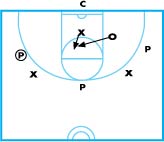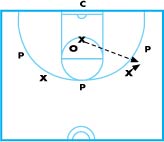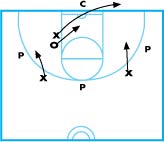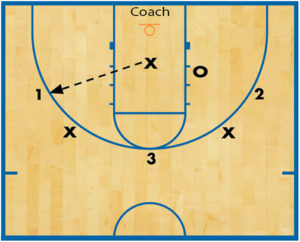Low-post defense and convert drill
This is a terrific drill that we run often. It has helped us with our interior defense, transition game and full-court pressing.

DIAGRAM 1: Initial setup. This shows the positioning to begin the drill. The offense has 3 perimeter passers and an inside post player. The defense has two outlet players and a defender inside. The coach is located under the basket to watch for proper post of defense.

DIAGRAM 2: Drill start up. The drill begins with the defensive post man passing the ball out to a perimeter passer.
It’s a good idea to limit your perimeter passers to three or four passes maximum to get the ball to the post. This ensures that the drill moves quickly so you can convert to the other end.
The offense wants its passers to exchange places on the perimeter to keep them from standing still.

DIAGRAM 3: Post denial. This shows the defender in the post, denying the flash as the drill begins.
We like our post defenders to make contact with the offensive post player and attempt to push him or her toward the top of the key. The offense continues to pass up to three to four times, looking to make a post feed.
When the offensive post player receives a pass and attempts a shot, the coaches must make sure that the post defender contests the shot and blocks out.
On a miss, we want to complete the defensive trip with a two-handed rebound and outlet pass to a teammate to at least the free-throw line extended (see Diagram 4).

DIAGRAM 4: Outlet pass. The team on offense now converts 3-on-4 to the other end. To work against pressure, we like to have the four defensive players trap the ball all over the floor. If during the drill the offensive post player scores, the other three players that were on defense can go full court against the other four players, who are now trapping and pressing in the full-court, as shown in Diagram 5.

DIAGRAM 5: Full-court trap after score.
Other drill options
• Add a fourth member for the defensive team at the 10-second line, and release them when the offense shoots. This forces the offensive team to make sure it covers transition defense when converting in a 4-on-4 situation.
• You can allow the three perimeter passers to either shoot 3-point shots or drive to the basket at any time. On any 3-pointers, the post defender must block out. On drives to the basket, he or she must look for help and hopefully draw the charge.
• It’s a good idea to limit the perimeter passers to three or four passes. You may also want to disallow any lob passes or not allow the lob until the perimeter passers run out of post entry passes.
• This drill is a great time to work on a specific post defense that you want to use against an upcoming opponent.












